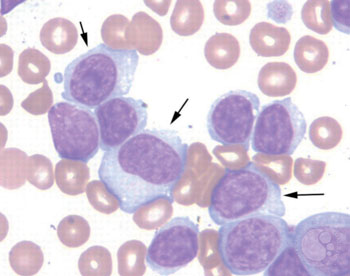Atypical Chronic Lymphocytic Leukemia Identified by Digital Microscopy
By LabMedica International staff writers
Posted on 09 Sep 2014
Digital microscopy has been used to morphologically classify chronic lymphocytic leukemia (CLL) patients as atypical chronic lymphocytic leukemia (aCLL) or typical CLL (tCLL), and determine the prevalence of prognostic markers in each group.Posted on 09 Sep 2014
In tCLL, which are approximately 80% of all cases, over 90% of the circulating lymphocytes are small-to-medium sized with relatively normal morphology, except for a characteristically clumped, chunky chromatin pattern.

Image: Photomicrograph of a blood film from a patient with atypical chronic lymphocytic leukemia. Lymphocytes were primarily small with round nuclei, condensed chromatin and scant cytoplasm. Approximately 20% of the lymphocytes had the morphologic features of prolymphocytes with finely dispersed chromatin and central nucleoli (arrows) (Photo courtesy of the American Society of Hematology).
Scientists at the Memorial Sloan Kettering Cancer Center (New York, NY, USA) evaluated the lymphocyte morphology on archived blood films of 97 CLL patients, and results of their prognostic marker analysis at diagnosis were obtained between January 2010 and December 2011. All patients included had a confirmed diagnosis of CLL; availability of results for complete blood count, immunophenotyping, immunoglobulin heavy chain V-III region VH26 (IgVH) mutation status, and fluorescence in situ hybridization (FISH) for trisomy 12 and deletions of 13q14, 6q, 17p (tumor protein 53, TP53), and 11q (ataxia telangiectasia mutated, ATM); and an archived peripheral blood film. The age of the archived blood films varied between 8 and 26 months.
The archived Romanowsky-stained blood films were reexamined using the Cellavision AB digital imaging system (Lund, Sweden). Additional lymphocyte subtypes were created within Cellavision for manual subclassification of variant forms seen in aCLL including prolymphocyte, large atypical lymphocyte, and cleaved lymphocyte. The team found that 27% of patients with CLL in their study were morphologically classified as aCLL, similar to that reported in the literature. The aCLL group had a higher prevalence of trisomy 12, unmutated IgVH, and cluster of differentiation 38 (CD38) expression markers associated with poor prognosis.
The authors concluded that using digital microscopy to morphologically identify lymphocyte subtypes and sub classify patients with CLL as tCLL or aCLL is a feasible, rapid, and inexpensive screening tool. Stable morphology consistent with tCLL over time may eliminate the need for more frequent and expensive genetic monitoring, while an unexpected change in morphologic sub classification from tCLL to aCLL may trigger a more extensive workup and a change in therapeutic approach. The study was published in the August 2014 issue of the International Journal of Laboratory Hematology.
Related Links:
Memorial Sloan Kettering Cancer Center
Cellavision AB













